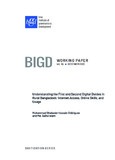Understanding the First and Second Digital Divides in Rural Bangladesh

Date
2020-12Publisher
BRAC Institute of Governance and Development (BIGD)Metadata
Show full item recordAbstract
Differences in individuals’ access to internet infrastructure refer to the first-level digital divide, whereas differences in an individual’s online skills and internet usage refer to the second-level digital divide. Bangladesh is a country with a clear-cut digital divide between rural and urban areas, which is primarily caused by income and wealth inequalities. But the uneven distribution of information and communications technologies (ICTs) between rural and urban areas contributes to the inequality in economic and social development. Therefore, the Government of Bangladesh (GoB) is taking initiatives to address the rural-urban divide in socio-economic development through the elimination of rural-urban disparities in the first- and second-level digital divides; this has become a key issue, as well as a major challenge for policymakers, practitioners, and academicians. The present research study uses the theory of digital divide stemming from a comparative phenomenon of different forms of inequalities and aims to generate meaningful insights about the spectrum of individual internet access and online skills (i.e. the first- and second-level digital divides) in the setting of rural Bangladesh, where there is a dearth of data as well as a research gap.
